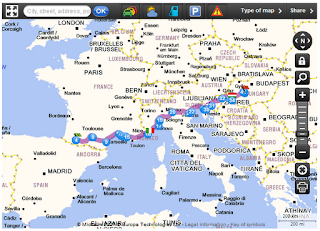Planning a cross-continent trip this summer from my paents' in S France to our family@large cottage in Hungary, my wife pointed out www.viaMichelin.co.uk. I'm familiar with paper Michelin maps of yore, that marked chevrons to signal the steepness of slopes - harks back to under powered cars mid last century, but were very handy for cycling which is what I used it for as a teen - or colored lines to signal scenic routes. Not to be outdone the web version marks black spots on roads as well as hotels, in an interactive roadmap on steroids.
 |
| click image to enlarge |
Luck would have it that Caitlin Dempsey @gislounge pointed out an Ancient Rome travel map from Stanford University. It calculates travel times in the Roman era across the Roman empire by season and with travel costs in the currency of the time. It's deceptively simple but entails a lot of calculations, a multimodal map on steroids if you will. I'm not sure what's more amazing, that what takes 18 hours direct today took 43 days two millennia ago, or that we can calculate that at all!
| click image to enlarge |
On the data creation side, Google's AtmosphereOnTour show early this week uncovered an intriguing site from the Met Office. While it does provide data online, it's notoriously hard to extract it and make good use of it. Somewhat of a turnaround is their posting of volunteer weather stations.
| click image to enlarge |
My friend Geo Dailey pointed out the most intriguing app for volunteers to record info on the transit of Venus. On Jun 5 and 6 next week, Venus will swing between Earth and the Sun: measuring the dark speck across the sun disk allowed early astronomers to measure the size of the solar system. This celestial conjunction doesn't happen that often as described my Matt Artz... Geo told me Captain Cook mounted an expedition in the Pacific to measure it in the 18th c.! Well then, contrast that mometous effort with perhaps thousands of volunteers measuring the transit of Venus because:
- there's a free iPad app available from Astronomers without Borders and Esri
- iPhones have cameras GPS and clinometers built in that allow such measuremts
click image to enlarge
click image to enlarge


No comments:
Post a Comment
Please send me a copy of your prospectus to